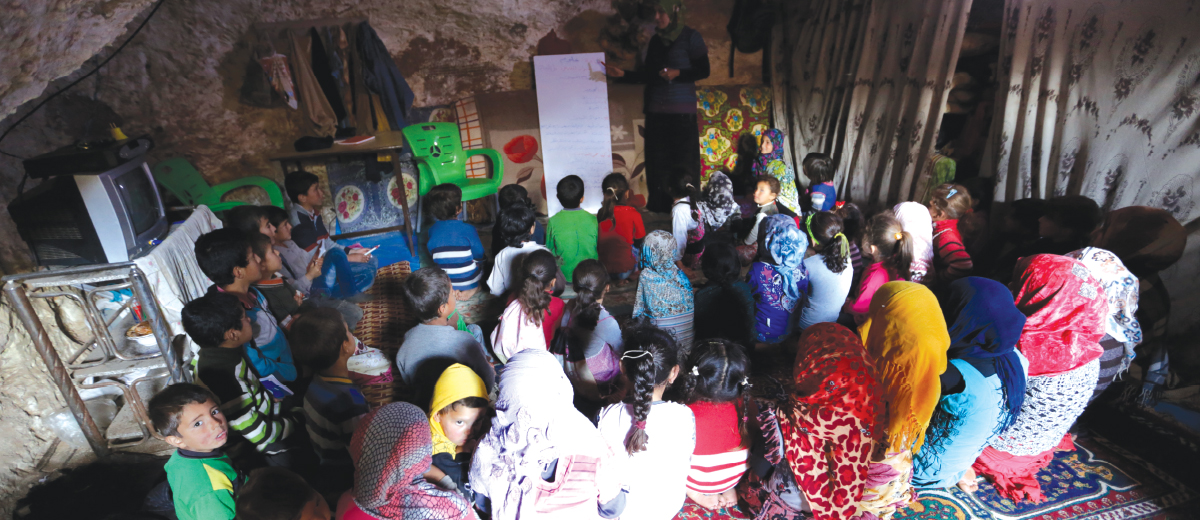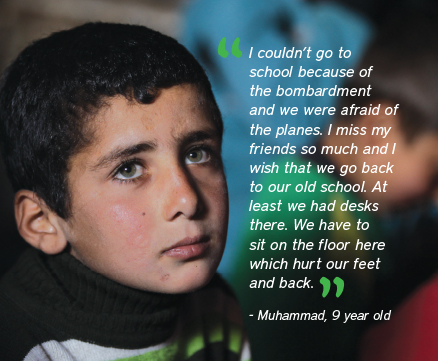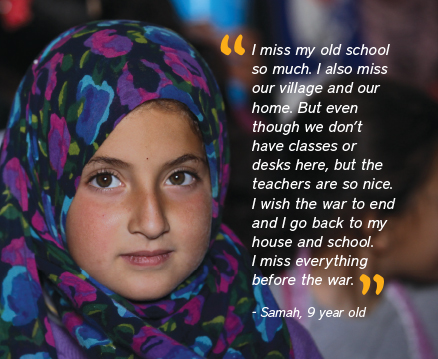
By UNICEF Syrian Arab Republic
Children in the Syrian Arab Republic risk their lives every day just to go to school. Since the conflict began in 2011, there have been more than 4,000 attacks on schools. In the northern governorate of Idleb, two former teachers have transformed a deserted cave into a classroom, so students can get an education in a safe place.
DAMASCUS, Syrian Arab Republic – In the Syrian Arab Republic, going to school for many children is fraught with danger. Every day, children and teachers risk their lives to reach a classroom, as schools continue to come under attack. Yet despite these risks, they persist in doing everything they can to get an education that is rightfully theirs. Their stories are ones of determination and resilience.
 One such story comes from a rural area in the northern Syrian governorate of Idleb. Almost all of the children who study at this school have fled violence in northern rural Hama over a year ago, and sought refuge in caves and tents that are spread along this rural area.
One such story comes from a rural area in the northern Syrian governorate of Idleb. Almost all of the children who study at this school have fled violence in northern rural Hama over a year ago, and sought refuge in caves and tents that are spread along this rural area.
The increasing number of students in the school stands as a testament to the children’s determination to learn despite the terrible odds stacked against them.
 Last year, some of the children living in rural Idleb had an opportunity to catch up on the education they have missed. Ahmad* and his wife, who were both teachers in Hama before they were displaced themselves, found a deserted cave which they cleaned up and turned into a school. “We started with children who live nearby, then we expanded and now we have almost 120 students,” he says.
Last year, some of the children living in rural Idleb had an opportunity to catch up on the education they have missed. Ahmad* and his wife, who were both teachers in Hama before they were displaced themselves, found a deserted cave which they cleaned up and turned into a school. “We started with children who live nearby, then we expanded and now we have almost 120 students,” he says.
The increasing number of students in the school stands as a testament to the children’s determination to learn despite the terrible odds stacked against them. “We have so many children coming now that we’ve had to divide the day into shifts according to children’s age,” Ahmad says. “The cave was too small to host all the children, so we have separate times for younger children to come and learn the alphabet, while the older ones who have already been to school learn other topics later.”
There are some drawbacks to running a school in a cave. “During last winter, the cave flooded and we considered stopping the whole project, but children insisted that we continue and we moved to a tent until the cave was dry again,” says Ahmad. “The school is too primitive, but at least it protects the children from bombardment.”
For the children who attend, it’s a bittersweet experience. Muhammad, aged 9, left his town in Hama 10 months ago. “I couldn’t go to school because of the bombardment and we were afraid of the planes. I miss my friends so much and I wish that we could go back to our old school. At least we had desks there. We have to sit on the floor here which hurts our feet and back,” he says.
For many Syrian children, school is a distant memory as the conflict has cost them over five years of their education. For others, it is a word they hear, not knowing what it actually is.
“I learn Arabic, English and mathematics, and I sometimes play with my friends.” says Nadia, also 9. “This school doesn’t have enough light but we are not scared here.”
For many Syrian children, school is a distant memory as the conflict has cost them over five years of their education. For others, it is a word they hear, not knowing what it actually is, having never seen the inside of a classroom. For all of them, education remains an ambition.
In today’s reality in the Syrian Arab Republic, one in three schools is not in use, and many of the schools that remain lack adequate teaching staff, water and hygiene facilities. Many children have been killed or injured in attacks. They live in constant fear as they don’t know when the next attack will come.
Back in Idleb, Ahmad and his wife continue to work unofficially under terrible circumstances. “We face so many difficulties,” Ahmad says. “There are so many things we need – textbooks, notebooks, clothes, schoolbags and other education materials,” he explains. “It is only the child who is losing because of this war,” Ahmad says. “If we don’t do anything for these children they will lose their education too.”
UNICEF has just launched a back-to-learning campaign aiming to reach 2.5 million children including 200,000 living in 59 besieged and hard-to-reach areas in Aleppo, Hasakeh, Hama, Homs, Idleb, Raqqa and Rural Damascus. UNICEF will provide children with education material, school bags and stationery. The campaign includes social mobilization to encourage parents to send their children to school or benefit from alternative learning opportunities where schools are no longer functioning.
UNICEF is supporting more than 1,200 dedicated young volunteers to conduct a massive door-to-door campaign to map the numbers and situation of out-of-school children, identify why these children are out of school and reach out to parents and children with information about simplified school enrollment processes and the right to education.
— This story was originally printed in the December 2016 issue of The Manitoba Teacher Magazine
